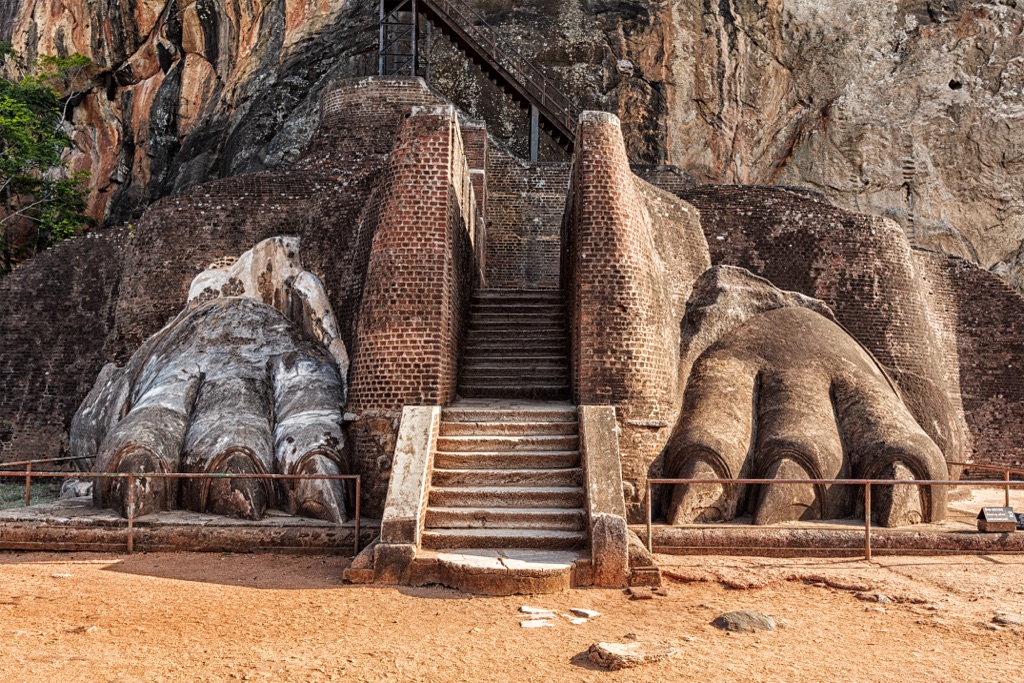Sigiriya, often hailed as the Eighth Wonder of the World, is a stunning ancient rock fortress located in the central Matale District near the town of Dambulla in the Central Province of Sri Lanka. Standing majestically at 200 meters high, it’s a testament to ancient engineering and urban planning. Sigiriya is famous for its palace ruins on top of a massive rock column, its complex hydraulic systems, and its exquisite frescoes. It’s a UNESCO World Heritage site and one of the best-preserved examples of ancient urban planning.
Get your dose of History via Email
Historical Background of Sigiriya
Sigiriya’s origins date back to the 5th century AD. It was built by King Kasyapa (477–495 AD) as his capital and royal palace. After his death, it became a Buddhist monastery until the 14th century. The site was then largely forgotten until the 19th century when it was rediscovered by British Army officer Jonathan Forbes in 1831. The site’s historical significance lies not only in its construction but also in its role as a testament to the cultural and technological advancements of the time.
The fortress was built by King Kasyapa as a power statement. He chose the site for its strategic advantages and natural defenses. After Kasyapa’s death, Sigiriya was converted into a Buddhist monastery, which lasted until the 14th century. This period of habitation left behind additional layers of history, including frescoes and inscriptions.
Sigiriya has witnessed significant historical events, including the power struggle that led to its creation. King Kasyapa, fearing an attack from his brother, built the fortress as a secure palace. The site’s later transition to a monastery indicates its continued importance to Sri Lankan culture and history.
Archaeological work at Sigiriya has revealed insights into ancient Sri Lankan society. Excavations have uncovered features that suggest the site was an important urban center. The sophisticated water gardens and hydraulic systems point to a high level of technological knowledge.
Today, Sigiriya stands as a symbol of Sri Lanka’s rich history. It attracts scholars and tourists alike, who come to marvel at its ancient frescoes, sophisticated architecture, and the ingenuity of its builders. The site continues to be an important focus for archaeological and historical research, shedding light on the island’s past.
About Sigiriya
Sigiriya is renowned for its unique geological and architectural features. The central rock column rises dramatically from the surrounding plains, dominating the landscape. The site’s layout includes elaborate gardens, reservoirs, and fortifications. The entrance is through a gateway in the form of an enormous lion, leading to its nickname ‘Lion Rock’.
The palace complex atop the rock is the focal point of Sigiriya. It includes the remains of the royal palace, audience hall, and terraced gardens. The construction techniques and materials used, such as massive stone walls and delicate frescoes, reflect a blend of practicality and artistry.
The Mirror Wall, once polished to a shine, contains verses dating from the 8th to the 10th century. These inscriptions provide insight into the thoughts and lives of ancient visitors. The frescoes, depicting celestial maidens, are among the most significant artistic treasures of Sigiriya.
The site’s water gardens showcase an advanced understanding of hydraulics. They feature fountains, pools, and water pavilions, which still function during the rainy season. The gardens are divided into three distinct but linked forms: symmetrical and asymmetrical gardens, and boulder gardens.
The fortress’s strategic design includes boulder arches and moats, highlighting the defensive purpose of Sigiriya. The combination of natural and man-made defenses made the site an impregnable stronghold in its time. The architectural highlights of Sigiriya are a testament to the ingenuity of ancient Sri Lankan civilization.
Theories and Interpretations
Several theories exist about Sigiriya’s original purpose and the meanings behind its features. Some suggest it was primarily a defensive fortress, while others believe it was a monastery or a pleasure palace. The true intent may be a combination of these functions, reflecting the complex nature of the site.
The frescoes and the Mirror Wall have sparked much debate among historians. Some interpret the frescoes as representations of celestial nymphs, while others see them as portraits of Kasyapa’s consorts. The inscriptions on the Mirror Wall add to the site’s mystique, with poetic verses that offer a glimpse into the minds of ancient visitors.
The advanced hydraulic system has led to speculation about the level of technological knowledge during the period. Researchers have marveled at the engineering skills required to create such a sophisticated water management system in the 5th century.
Archaeological excavations have provided some answers, but many aspects of Sigiriya remain shrouded in mystery. The site’s alignment and the astronomical significance of its layout are subjects of ongoing research, as scholars attempt to decode its ancient secrets.
Dating of Sigiriya has been carried out using traditional archaeological methods. These include the analysis of construction techniques and the study of inscriptions and historical records. The consensus places the construction of Sigiriya during King Kasyapa’s reign in the late 5th century.
At a glance
Country: Sri Lanka
Civilization: Ancient Sri Lankan
Age: Approximately 1,500 years old (5th century AD)

